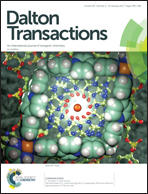Physical and chemical properties of Cu(i) compounds with O and/or H
Abstract
The electronic structure and chemical bonding of Cu(I) compounds with O and/or H are investigated using ab initio calculations based on density functional theory. A hybrid functional PBE0 is employed, which accurately reproduces an experimental band gap of cuprite Cu2O. Cuprous hydroxide CuOH (cuprice) is found to be an indirect band gap semiconductor. Depending on the bond network configuration of CuOH, its band gap is found to vary between 2.73 eV and 3.03 eV. The presence of hydrogen in CuOH has little effect on the character of Cu–O bonds, as compared to Cu2O, but lowers the energy levels of the occupied states upon O–H bond formation. The bonding charge density and electron localization function calculations reveal that a closed-shell Cu–Cu interaction takes place in Cu2O and CuOH between the neighbouring Cu cations belonging to different bond networks. Besides, three structures of cuprous hydride CuH are investigated. We find that the halite structure of CuH can be stabilized at high pressure (above 32 GPa) while wurtzite is the most stable structure of CuH at ambient pressure. The H–H interaction contributes to the dynamical stabilization of the halite structure. The wurtzite and sphalerite structures of CuH are predicted to be semiconducting with small band gaps, while the halite structure is calculated to be metallic.



 Please wait while we load your content...
Please wait while we load your content...